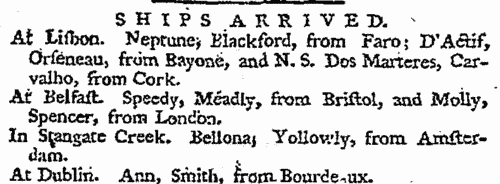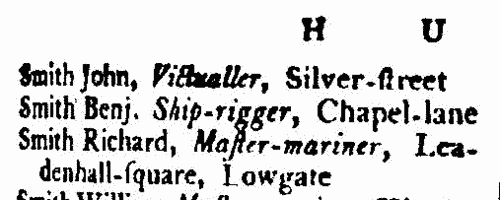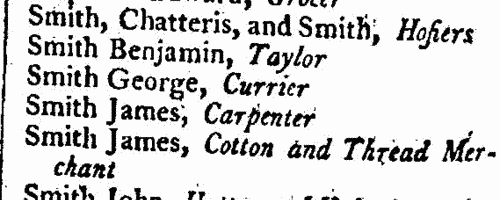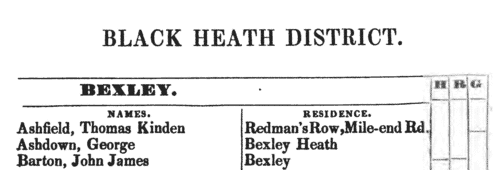Smeed Surname Ancestry ResultsOur indexes 1000-1999 include entries for the spelling 'smeed'. In the period you have requested, we have the following 65 records (displaying 1 to 10): Single Surname Subscription | | | Buying all 65 results of this search individually would cost £358.00. But you can have free access to all 65 records for a year, to view, to save and print, for £100. Save £258.00. More... |
These sample scans are from the original record. You will get scans of the full pages or articles where the surname you searched for has been found. Your web browser may prevent the sample windows from opening; in this case please change your browser settings to allow pop-up windows from this site. Allegations for marriages in southern England
(1679-1687)
The province or archbishopric of Canterbury covered all England and Wales except for the northern counties in the four dioceses of the archbishopric of York (York, Durham, Chester and Carlisle). Marriage licences were generally issued by the local dioceses, but above them was the jurisdiction of the archbishop, exercised through his vicar-general. Where the prospective bride and groom were from different dioceses it would be expected that they obtain a licence from the archbishop; in practice, the archbishop residing at Lambeth, and the actual offices of the province being in London, which was itself split into myriad ecclesiastical jurisdictions, and spilled into adjoining dioceses, this facility was particularly resorted to by couples from London and the home counties, although there are quite a few entries referring to parties from further afield. The abstracts of the allegations given here usually state name, address (street in London, or parish), age, and condition of bride and groom; and sometimes the name, address and occupation of the friend or relative filing the occupation. Where parental consent was necessary, a mother's or father's name may be given. The ages shown should be treated with caution; ages above 21 tended to be reduced, doubtless for cosmetic reasons; ages under 21 tended to be increased, particularly to avoid requiring parental consent; a simple statement 'aged 21' may merely mean 'of full age' and indicate any age from 21 upwards. These are merely allegations to obtain licences; although nearly all will have resulted in the issuing of the licence, many licences did not then result in marriage. SMEED. Cost: £4.00.  | Sample scan, click to enlarge

| Captains of coasters entering the port of London
(1785)
The Custom House in the port of London posted daily lists of ships. The Coast List was in four parts - Colliers Entered Inwards; Coasters Entered Inwards; Coasters Entered Outwards (i. e., receiving cargo for a prospective voyage); and Coasters Cleared Outwards. Coasters entered inwards are listed by name with the surname of the captain, the name of the port from which they had come, and the number of the wharf at which they were docked (1 Topping's Wharf, 2 Chamberlain's Wharf, 3 Cotton's Wharf, 4 Bridge Yard, 5 Hayes's Wharf, 6 Beal's Wharf, 7 Yoxall's Wharf, 8 Griffin's Wharf, 9 Gun and Shot Wharf, 10 Simmon's Wharf, 11 Stanton's Wharf and 12 Dobbyn's Wharf, all at Tooley Street, Southwark; 13 Three Cranes Wharf, 14 Red Lion Wharf and 15 Bell Wharf, all at Upper Thames Street, London; 16 Fresh Wharf, 17 Billingsgate Dock, 18 Smart's Key, 19 Dice Key, 20 Custom-House Key, 21 Wool Key and 22 Chester Key, all at Lower Thames Street, London; 23 Iron Gate Wharf, 24 Wheeler's Wharf and 25 Harrison's Wharf, all at St Catharine's, London; 26 Scotch Wharf, 27 Hawley's Wharf and 28 Hore's Wharf, all at Hermitage; 29 Dublin Chains, 30 Yarmouth Chains, 31 Tower Chains, 32 Parsons's Chains, 33 Pickle Herring Chains, 34 Horslydown Chains, 35 Hermitage Chains, 36 Old Rose Chains; 37 Iron Gate Stairs, 38 Union Stairs, 39 East Lane Stairs, 40 Pickle Herring Stairs, 41 Wapping Old Stairs, 42 Wapping New Stairs, 43 King Edward's Stairs, 44 New Crane Stairs, 45 King James's Stairs, 46 Pelican Stairs, 47 Shadwell Stairs, 48 Bell Wharf Stairs, and 49 Stone Stairs). These lists were printed in the Daily Universal Register. May 1785.SMEED. Cost: £6.00.  | Sample scan, click to enlarge

| Masters of Merchantmen
(1785)
The Daily Universal Register of April 1785 includes a section entitled Ship News. This is compiled from reports from Portsmouth, Deal, Plymouth, Whitby, Cowes, Falmouth, Bristol and Gravesend as to merchant shipping movements; news of losses and sightings coming in from various ports; a list of Ships Arrived in the (London) River, in the Clyde, in the Creek(e), in the Downs, off the Lizard, off Scilly, off the Start, in Studland Bay, off Whitby, off the Wight, at Aberdeen, Alicante, Ancona, Antigua, Baltimore, Barbadoes, Barcelona, Bayonne, Belfast, Bombay, Bonny, Bordeaux, Brighthelmstone (Brighton), Bristol, Cadiz, Carlingford, Cartagena, Charlestown, Cork, Cowes, Cuxhaven, Dartmouth, Dominica, Dover, Dublin, Dunkirk, Falmouth, Galway, Gibraltar, Grenada, Guernsey, Halifax (Nova Scotia), Hamburg, Havre de Grace, Hull, Jersey, Kinsale, Lancaster, Leghorn, Limerick, Lisbon, Liverpool, Londonderry, Lochryan, Malaga, Marseilles, Montserrat, Nantes, New Providence (Bahamas), New York, Newry, Oporto, Ostend, Penzance, Plymouth, Poole, Portsmouth, Rotterdam, St Eustatia, St John's, St Kitts, St Vincents, Scarborough, Scilly, Seville, Southampton, Stangate Creek, Tenerife, Texel, Tobago, Venice, Waterford, Weymouth, Whitehaven, and in 'Africa', Georgia, Jamaica, Maryland, North Carolina, Philadelphia, South Carolina and Virginia; and Coast Lists made at the Custom House in London. Except in the home ports, the register refers only to British shipping: each ship is usually identified merely by its name, and the master's surname, although masters' christian names are given occasionally. Naval vessels are mentioned rarely, and their captains' names not usually stated. SMEED. Cost: £6.00.  | Sample scan, click to enlarge

| Inhabitants of Hythe in Kent
(1790-1797)
The provincial sections of the Universal British Directory include lists of gentry and traders from each town and the surrounding countryside, with names of local surgeons, lawyers, postmasters, carriers, &c. (the sample scan here is from the section for Hull). The directory started publication in 1791, but was not completed for some years, and the provincial lists, sent in by local agents, can date back as early as 1790 and as late as 1797.
SMEED. Cost: £6.00.  | Sample scan, click to enlarge

| Inhabitants of Sandwich in Kent
(1790-1797)
The provincial sections of the Universal British Directory include lists of gentry and traders from each town and the surrounding countryside, with names of local surgeons, lawyers, postmasters, carriers, &c. (the sample scan here is from the section for Nottingham). The directory started publication in 1791, but was not completed for some years, and the provincial lists, sent in by local agents, can date back as early as 1790 and as late as 1797.
SMEED. Cost: £6.00.  | Sample scan, click to enlarge

|  Apprentices registered in East Kent
(1797) Apprentices registered in East Kent
(1797)
Apprenticeship indentures and clerks' articles were subject to a 6d or 12d per pound stamp duty: the registers of the payments usually give the master's trade, address, and occupation, and the apprentice's name, as well as details of the date and length of the apprenticeship. There are central registers for collections of the stamp duty in London, as well as returns from collectors in the provinces. These collectors generally received duty just from their own county, but sometimes from further afield. The indentures themselves can date from a year or two earlier than this return. (The sample entry shown on this scan is taken from a Bristol return. Each entry has two scans, the other being the facing page with the details of the indenture, length of service, and payment of duty.) IR 1/68SMEED. Cost: £8.00.  | Sample scan, click to enlarge

| Prisoners at Maidstone
(1832)
The return from the County Gaol and House of Correction at Maidstone from 1 January to 31 December 1832 lists all prisoners (full name), place from whence committed, number of days detained in the year (before final commitment; after final commitment; and after conviction), and sentence, giving time of imprisonment (if any), or whether acquitted, discharged, executed, transported, whipped, or died in gaol.SMEED. Cost: £6.00.  | Sample scan, click to enlarge

| Electors in Tonbridge
(1835)
A poll to elect knights of the shire to represent the Western Division of the county of Kent in parliament was held in 1835, the candidates being Thomas Law Hodges (H), Thomas Rider (R) and sir William R. P. Geary (G). The poll started on January 19th; Rider withdrawing his name on that first day, the poll was closed prematurely, many electors not yet having voted. This poll book lists all the electors, whether they voted or not; the county franchise included not only male freeholders of 40s a year, but also £10 copyholders and long-leaseholders, and £50 short-leaseholders and tenants. For each elector the full name is given (surname first) and residence (often not the place for which qualified to vote). Votes are indicated by dashes in the right-hand columns. SMEED. Cost: £4.00.  | Sample scan, click to enlarge

|  Persons of standing recommending London police recruits
(1830-1842) Persons of standing recommending London police recruits
(1830-1842)
The Metropolitan Police Register of Joiners (MEPO 333/4) lists policemen joining the force through to 31 December 1842 (to warrant number 19892). The register is alphabetical, in so far as the recruits are listed chronologically grouped under first letter of surname. It is evidently a continuation of a similar earlier register, not closed until its alphabetical sections were filled: consequently, there are no entries in this register for the initial letters N, O, Q, U, V, X, Y or Z; and the sections of this register start at different dates - A 18 April 1840 (warrant number 16894); B 11 December 1830 (5570); C 7 September 1830 (4988); D 27 May 1833 (8445); E 15 December 1838 (14476); F 30 March 1832 (7372); G 1 December 1835 (11,184); H 25 April 1832 (7457); I and J 13 February 1837 (12449); K 2 January 1838 (13457); L 3 October 1834 (9905); M 15 November 1832 (7999); P 4 October 1831 (6869); R 4 September 1837 (13021); S 30 March 1835 (10366); T 6 April 1840 (16829); W 30 December 1833 (9096). The register gives Date of Appointment, Name, Number of Warrant, Cause of Removal from Force (resigned, dismissed, promoted or died), and Date of Removal. Those recruits not formerly in the police, the army, or some government department, were required to provide (normally) at least two letters of recommendation from persons of standing, and details of these are entered on the facing pages: the names in these are indexed here (the police recruits are indexed separately and not included here). Recruits transferred from other forces or rejoining the force did not normally need recommendations - in the latter case, former warrant numbers are given - but some recommendations are from police inspectors, even other constables. Recruits coming from the army sometimes have general military certificates of good conduct, but most often have a letter from their former commanding officer; recruits recommended by government departments (most often the Home Office) similarly have letters from the head of department. But the great majority of the names and addresses in these pages are of respectable citizens having some sort of personal acquaintance with the recruit. Where more than two recommendations were provided, the clerk would only record one or two, with the words 'and others'. Tradesmen are sometimes identified as such by their occupations; there are some gentry. Although the great bulk of these names are from London and the home counties, a scattering are from further afield throughout Britain and Ireland. SMEED. Cost: £8.00.  | Sample scan, click to enlarge

| Insolvents
(1844)
Insolvency notices for England and Wales: insolvency often caused people to restart their lives elsewhere, so these are an important source for lost linksSMEED. Cost: £6.00.  | Sample scan, click to enlarge

|
Research your ancestry, family history, genealogy and one-name study by direct access to original records and archives indexed by surname.
|













